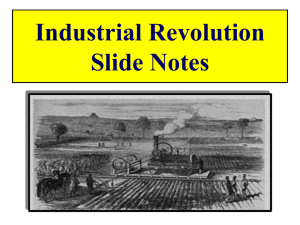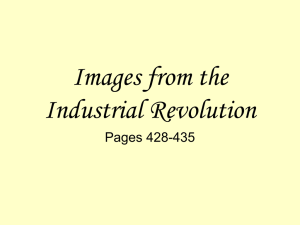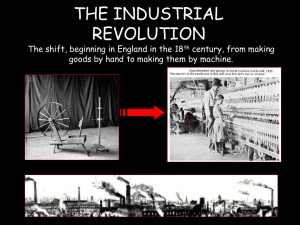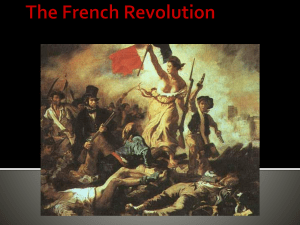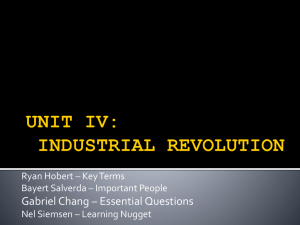AP World History: The Industrial Revolution
advertisement
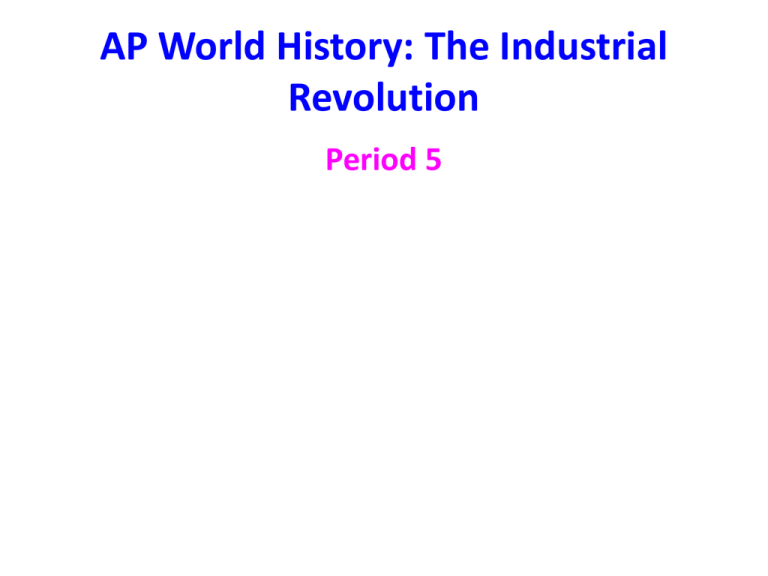
AP World History: The Industrial Revolution Period 5 I What Was the Industrial Revolution? The Industrial Revolution, which took place from the 18th to 19th centuries, was a period during which predominantly agrarian, rural societies in Europe and America became industrial and urban. Prior to the Industrial Revolution, which began in Britain in the late 1700s, manufacturing was often done in people’s homes, using hand tools or basic machines. Industrialization marked a shift to powered, special-purpose machinery, factories and mass production. The iron and textile industries, along with the development of the steam engine, played central roles in the Industrial Revolution, which also saw improved systems of transportation, communication and banking. While industrialization brought about an increased volume and variety of manufactured goods and an improved standard of living for some, it also resulted in often grim employment and living conditions for the poor and working classes. II How it Began A) Before the advent of the Industrial Revolution, most people resided in small, rural communities where their daily existences revolved around farming. Life for the average person was difficult, as incomes were meager, and malnourishment and disease were common. People produced the bulk of their own food, clothing, furniture and tools. Most manufacturing was done in homes or small, rural shops, using hand tools or simple machines. This gave rise to the term “cottage industry”. B) A number of factors contributed to Britain’s role as the birthplace of the Industrial Revolution. For one, it had great deposits of coal and iron ore, which proved essential for industrialization. Additionally, Britain was a politically stable society, as well as the world’s leading colonial power, which meant its colonies could serve as a source for raw materials, as well as a marketplace for manufactured goods (mercantilism). C) As demand for British goods increased, merchants needed more cost-effective methods of production, which led to the rise of mechanization and the factory system. III The Enclosure Movement in Britain “Enclosure is the process which was used to end traditional rights, and has historically been accompanied by force, resistance, and bloodshed. It has been referred to as "among the most controversial areas of agricultural and economic history in England." The Enclosure Movement was a push in the 18th and 19th centuries to take land that had formerly been owned in common by all members of a village, or at least available to the public for grazing animals and growing food, and change it to privately owned land, usually with walls, fences or hedges around it. The most well-known Enclosure Movements were in the British Isles, but the practice had its roots in the Netherlands and occurred to some degree throughout Northern Europe and elsewhere as industrialization spread. Some small number of enclosures had been going on since the 12th century, especially in the north and west of England, but it became much more common in the 1700s, and in the next century Parliament passed the General Enclosure Act of 1801 and the Enclosure Act of 1845, making enclosures of certain lands possible throughout England, Wales, Scotland, and Ireland. The English government and aristocracy started enclosing land claiming it would allow for better raising of crops and animals (particularly sheep for their wool). They claimed that large fields could be farmed more efficiently than individual plots allotted from common land -- and the profit could be kept by the aristocrats who now owned the legally confiscated land. Some claim this was the beginning of commercial farming.” http://www.celdf.org/article.php?id=638 Enclosure Movement Coal Mining in Britain 1800 - 1914 1800 1 ton of coal 50, 000 miners 1850 30 tons 200, 000 miners 1880 300 million tons 500, 000 miners 1914 250 million tons 1, 200, 000 miners British Pig Iron Production The Opening of the Bridgewater Canal 1761 CE by Ford Madox Brown IV Innovation A) In the 1700s, a series of innovations led to ever-increasing productivity, while requiring less human energy. For example, around 1764, Englishman James Hargreaves (1722-1778) invented the spinning jenny (“jenny” was an early abbreviation of the word “engine”), a machine that enabled an individual to produce multiple spools of threads simultaneously. By the time of Hargreaves’ death, there were over 20,000 spinning jennys in use across Britain. The spinning jenny was improved upon by British inventor Samuel Compton’s (1753-1827) spinning mule, as well as later machines. Another key innovation in textiles, the power loom, which mechanized the process of weaving cloth, was developed in the 1780s by English inventor Edmund Cartwright (1743-1823). Spinning Jenny Power Loom Innovation Continued… B) Developments in the iron industry also played a central role in the Industrial Revolution. In the early 18th century, Englishman Abraham Darby (1678-1717) discovered a cheaper, easier method to produce cast iron, using a coke-fueled furnace (as opposed to charcoal-fired) furnace. In the 1850s, British engineer Henry Bessemer (1813-1898) developed the first inexpensive process for mass-producing steel. Both iron and steel became essential materials, used to make everything from appliances, tools and machines, to ships, buildings and infrastructure. C) The steam engine was also integral to industrialization. In 1712, Englishman Thomas Newcomen (1664-1729) developed the first practical steam engine (which was used primarily to pump water out of mines). By the 1770s, Scottish inventor James Watt (1736-1819) had improved on Newcomen’s work, and the steam engine went on to power machinery, locomotives and ships during the Industrial Revolution. The First Cast Iron Bridge, Coalbrookdale, 1779 The Bessemer Process The Bessemer Process was the first inexpensive process for the mass-production of steel from molten pig iron. It is the removal of impurities from the iron by oxidation wit air being blown through the molten iron. The oxidation also raises the temperature of the iron mass and keeps it molten. Bessemer Steel Workers V Transportation The transportation industry also underwent significant transformation during the Industrial Revolution. Before the advent of the steam engine, raw materials and finished goods were hauled and distributed via horse-drawn wagons, and by boats along canals and rivers. In the early 1800s, American Robert Fulton (1765-1815) built the first commercially successful steamboat, and by the mid-19th century, steamships were carrying freight across the Atlantic. As steam-powered ships were making their debut, the steam locomotive was also coming into use. In the early 1800s, British engineer Richard Trevithick (1771-1833) constructed the first railway steam locomotive. In 1830, England’s Liverpool and Manchester Railway became the first to offer regular, timetabled passenger services. By 1850, Britain had more than 6,000 miles of railroad track. Additionally, around 1820, Scottish engineer John McAdam (1756-1836) developed a new process for road construction. His technique, which became known as macadam, resulted in roads that were smoother, more durable and less muddy. Impact of the Railroad, Britain Steam Tractor Steam Locomotive, Canada CONSTERNATION AT THE SIGHT OF FULTON'S MONSTER Steam Ship, South Africa Macadam Road, California VI Communication and a Changing Economy A) Communication became easier during the Industrial Revolution with such inventions as the telegraph. In 1837, two Brits, William Cooke (1806-1879) and Charles Wheatstone (1802-1875), patented the first commercial electrical telegraph. By 1840, railways were a Cooke-Wheatstone system, and in 1866, a telegraph cable was successfully laid across the Atlantic. B) The Industrial Revolution also saw the rise of banks and industrial financiers, as well as a factory system dependent on owners and managers. A stock exchange was established in London in the 1770s; the New York Stock Exchange was founded in the early 1790s. C) In 1776, Scottish social philosopher Adam Smith (1723-1790), who is regarded as the founder of modern economics, published “The Wealth of Nations.” In it, Smith promoted an economic system based on free enterprise, the private ownership of means of production, and lack of government interference. Morse-Vail Telegraph Key, 1845 Major Telegraph Lines, 1891 London Stock Exchange New York Stock Exchange Today VII A Changing Society A) The Industrial Revolution brought about a greater volume and variety of factoryproduced goods and raised the standard of living for many people, particularly for the middle and upper classes. However, life for the poor and working classes continued to be filled with challenges. Wages for those who labored in factories were low and working conditions could be dangerous and monotonous. Unskilled workers had little job security and were easily replaceable. B) Children were part of the labor force and often worked long hours and were used for such highly hazardous tasks as cleaning the machinery. In the early 1860s, an estimated one-fifth of the workers in Britain’s textile industry were younger than 15. C) Industrialization also meant that some craftspeople were replaced by machines. Additionally, urban, industrialized areas were unable to keep pace with the flow of arriving workers from the countryside, resulting in inadequate, overcrowded housing and polluted, unsanitary living conditions in which disease was rampant. In cities many poor laborers lived together in tenements (crowded apartment buildings). Conditions for the workingclass began to gradually improve by the later part of the 19th century, as the government instituted various labor reforms and workers gained the right to form trade unions. D) The word "luddite" refers to a person who is opposed to technological change. The term is derived from a group of early 19th century English workers who attacked factories and destroyed machinery as a means of protest. They were supposedly led by a man named Ned Ludd, though he may have been an apocryphal figure. Factory Wages in Lancashire, 1830 Child Coal Miners, 1907 “Match” Girls Match girls worked long hours in the factories (usually from 6 AM to 6 PM) with only two short breaks. They were not allowed to talk or even sit down while they worked (otherwise they would be fined or fired). The girls only made 4 shillings a day, but they were also heavily fined if they dropped a match, talked to each other, sat down, arrived late, or went to the bathroom without permission (sometimes they went home with no pay at all). Beatings were not uncommon at the factories as well. http://britishindustrialrevolution.weebly.com/child-labormatch-girls.html Tenement NYC 1890 by Jacob Riis Stereotype of the Factory Owner Luddites 1811 - 1816 VIII The Industrial Revolution Spreads The British enacted legislation to prohibit the export of their technology and skilled workers; however, they had little success in this regard. Industrialization spread from Britain to other European countries, including Belgium, France and Germany, and to the United States. By the mid-19th century, industrialization was well-established throughout the western part of Europe and America’s northeastern region. By the early 20th century, the U.S. had become the world’s leading industrial nation. http://www.history.com/topics/industrial-revolution IX Was Malthus Right? A)Thomas Malthus (1766 – 1834) was an English economist. B)In An Essay on the Principle of Population as it affects the Future Improvement of Society he argued that increases in population would eventually diminish the ability of the world to feed itself and based this conclusion on the thesis that populations expand in such a way as to overtake the development of sufficient land for crops. “The superior power of population cannot be checked without producing misery or vice.” “Population, when unchecked, goes on doubling itself every 25 years or increases in a geometrical ratio.” Malthus Continued… “Thomas Malthus was an employee of the British East India Company who hit upon the idea that food production increases arithmetically while population increases exponentially. Thus, argued Malthus in his infamous 1798 “Essay on the Principle of Population,” it was a mathematical certainty that the world was on a crash course for demographic disaster. The problem for Malthus and his acolytes, however, is that they have in each and every generation failed to understand that the question of population and resources is not a zero-sum game. In each and every generation since Malthus first wrote his treatise, human ingenuity has developed technologies and techniques that have helped to expand the arable land for farming and agriculture and increased the number of crops that can be grown in each acre, even as the number of people required to work that land has fallen. Every generation a new crop of Malthusians emerge to argue that this time the expansion of the food supply will fail and the world will be plunged into chaos, and in each and every generation the predicted apocalypse has failed to arrive… Unfortunately we don’t have to dig very deep to see the dark side of this Malthusian bent. In 1969, Ehrlich stated that if voluntary birth control methods did not curb population growth fast enough for his liking, governments might have to consider “the addition of a temporary sterilant to staple food or to the water supply.” In 1972 UN climate guru Maurice Strong argued that governments should license couples to have children. In 1977, Obama “science czar” John Holdren mused once again about the possibility of forced abortions and sterilants in the water supply as a way of curbing population growth... Interestingly, even the UN’s own population and fertility estimates show that overpopulation is not the real problem. The UN is projecting a world population of 9 billion by 2050 and a leveling off after that point. The global fertility rate (children per couple) was 4.95 in 1950-1955. It was 2.79 in 2000-2005. It is expected to be 1.63 in 2095-2100. To put that in perspective, the replacement fertility rate that would be required to maintain the population at current levels is projected to be 2.1 in developed countries and as high as 3.4 in developing countries due to higher child mortality rates. With a global fertility rate of 1.63 by the end of the century, the human race will be essentially breeding itself out of existence. Quite contrary to the projections of the Malthusians, the very real danger to the economy and the species itself is the very real demographic shift that happens in a shrinking population. Population is still growing because of high fertility rates in previous generations and longer life spans, but declining fertility rates will turn into population decline in a number of nations within the century should these trends hold. The countries of the developed world, with their fertility rates already in decline, will be the first to experience the effects of this transition. Countries like Greece, Russia, Taiwan, Lithuania, South Korea and others that already have a fertility rate below 1.5 and little influx of immigrants are either already declining in population or are expected to within a decade.” –James Corbett, 2012 Did the Industrial Revolution Really Begin in England? “More than a decade before James Watt invented his improved steam engine and launched the industrial revolution in England, Benjamin Franklin had devised a working electric motor…Franklin took an interest in electricity in 1747 after receiving an "electric tube" from a friend. Over the next few years, he conducted experiments sporadically and collected examples of the latest electrical instruments. Like other scientists, he explored the ability of various materials to accumulate charges and the curious attractions or repulsions these charged bodies had for each other. By 1748, however, he had come up with an invention of his own. Calling it the "electric wheel," Franklin's machine consisted of a vertical shaft that was free to rotate, from which several glass bars extended like spokes. Each bar was tipped with a brass thimble. Placing the terminal of a "negatively charged" (as Franklin understood it) Leyden jar near the wheel allowed the thimble/glass assemblies to act as capacitors; as each assembly charged up, it tended to be repelled from the Leyden jar. A second, "positively charged" jar set nearby had the opposite effect, pulling the spokes toward it. The result was that the wheel would begin to rotate, and it would remain in motion until the charges on the Leyden jars dissipated. The motor was only strong enough to continue turning at 12 to 15 rpm when loaded with 100 Spanish dollars. Franklin probably suspected that even a full-scale version of his electrostatic motor could not compete with steam engines or water wheels as a practical source of power for industry. However, he suggested that if a turkey were mounted on the shaft and the whole thing placed before a fire, the wheel could be used as a sort of automatic spit. Unfortunately, he never reduced this protorotisserie idea to practice.” http://www.todaysengineer.org/2002/aug/heritage.asp Industrial Revolution and the Great Divergence Between East and West by Shamkhal Abilov, 2011 David S. Landes, the emeritus professor of economics at Harvard University, writes that during Medieval Ages the Orient, mainly China, had possessed a power-driven spinning machine and industrial techniques centuries before the Industrial Revolution occurred in the Occident. The wealth and economic growth of China during that time made it one of the big commercial centres of the world trade; the Chinese practiced coal production for iron smelting and industrial use, and also “were turning out perhaps as many as 125,000 tons of pig iron by the late eleventh century”.[1] He lists various inventions considered industrial priorities in China during that period and not in Europe, such as: the wheelbarrow, the stirrup, the rigid horse collar, the compass, paper, printing, gunpowder, and porcelain. These, however, were the key components for the Industrial Revolution in Europe later.[2] In comparison to China, though, during the Medieval Ages European societies were living in backwardness, their economic situation was in ruin, and Europe was suffering from a great number of foreign invasions. Regarding this, Landes elucidates: The Europe of what we call the Middle Ages (say, tenth century) had regressed from the power and pomp of Greece and Rome, had lost much of the science it had once possessed, had seen its economy retreat into generalized autarky[3]... The probability at that point of European global dominance was somewhere around zero... In the tenth century, Europe was just coming out of a long torment of invasion, plunder, and rapine, by enemies from all sides.[4] Great Divergence Continued… But despite the above-mentioned factors, the nineteenth century was a big challenge by Europe in the world’s economic history, a change considered as the appearance of a “Great Divergence” between the Orient and Occident. Despite the privileges of China and the greater technological development it had possessed for centuries, Europe entered into world history with immense developments in technology, later identified as the Industrial Revolution by world historians. For that reason, we find one of the questions that scholars of the subject greatly discuss today: if China had a priority over the rest of world in terms of technological development and economic-sense for almost a millennium, and was in the same development level with the most-developed parts of Europe around the eighteenth century (England and the Netherlands), why, then, did the Industrial Revolution occur in England, and not in China? Or, as Landes points out, “a thousand years ago, the Chinese were well ahead of anyone else and certainly of Europe. Some would argue that this superiority held for centuries thereafter...and, almost every element usually regarded by historians as a major contributory cause to the Industrial Revolution in north-western Europe was also present in China. Why, then, did China “fail”?”.[5] I think it is erroneous to ask why “China failed”, because the technological development that China possessed during the European Industrial Revolution did not stagnate; rather, it was on the same path in the eighteenth century as it was in medieval age, but it was the case that technological development did not revolutionize the Chinese economy as it did in England… Great Divergence Continued… Pomeranz, in turn, also determines coal as a central factor of the Industrial Revolution in England. Easy access to large sources of coal is, according to his argumentation, considered one of the vital factors for England’s revolution. He argues that, unlike China, much of the coal was relatively close to the major population and industrial regions of England, and England had accessible deposits of coal near manufacturing centres, which “provided both a rich and needy market and a pool of craftsmen who made crucial improvements in pumps, steam engines, and so on”.[47] Regarding China, its coal deposits were far from the centre, located in Shaanxi, several hundred landlocked miles from the industrialised Yangzi Delta. Pomeranz compares it as “a bit like if Europe's coal had mostly been under the Carpathian Mountains”.[48] Frank also sees the great distance of China’s coal deposits as a major reason for the “failure” of Chinese technology. He writes, China's natural deposits of coal were distant from its possible utilisation for the generation and industrial use of power, so that progressive deforestation still did not make it economical to switch fuel from wood to coal. Moreover, transport via inland canals and coastal shipping, as well as by road, remained efficient and cheap (but not from outlying coal deposits).[49]… Focus Questions 1. How did the Industrial Revolution begin and why? 2. What were the most important developments in the Industrial Revolution? How did they change society; for the better or worse? 3. Why did Thomas Malthus argue that industrialization would lead to an increased population? Why do some people today argue that this viewpoint is dangerous and wrong? What do you think? 4. According to Shamkhal Abilov, why did the Industrial Revolution not start in China? Do you agree or disagree?
